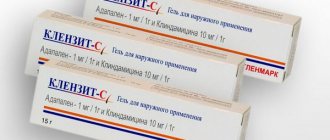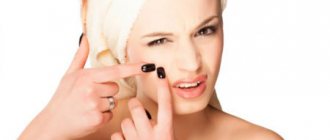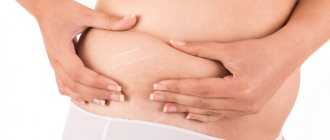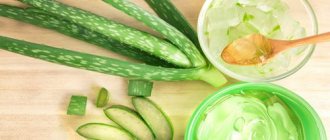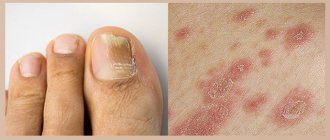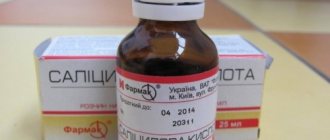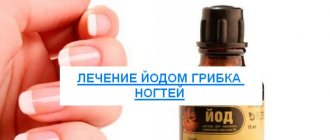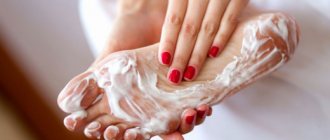Composition, release form and price
Nizoral is produced in several forms: shampoo, vaginal suppositories, cream and tablets. The active component of the drug is ketoconazole - it has a positive therapeutic effect on systemic and external mycotic infections.
Nizoral cream helps get rid of nail fungus effectively and in a short time. If we are talking about deep tissue damage and the transition of the disease to the chronic stage, the specialist additionally prescribes a tablet form of the drug. Systemic exposure not only helps cure onychomycosis, but also prevents the possibility of re-infection of the body.
Let's look at the composition of Nizoral cream and tablets in the table.
| Release form | Description of Included Components |
| CREAM |
|
| PILLS |
|
Prices for Nizoral are rightfully considered affordable. You can buy a 15 ml cream in Russian pharmacies for 550 rubles, in Ukrainian - 169 grams. The tablets are packaged in packs of 30 pieces - the price for them is 650 rubles. and 240 gr. respectively.
What is Nizoral cream
The drug is a homogeneous white cream exclusively for external use. Nizoral is not used in ophthalmic practice. Among patients, this drug is called Nizoral ointment. The drug is produced in tubes of 15 g, additionally packaged in cardboard boxes. It is recommended to store the product at a temperature of 15-30 degrees. The storage location must be inaccessible to children. The shelf life of the cream is 5 years. The use of Nizoral after the expiration date is not recommended.
Compound
The main active ingredient of Nizoral is ketoconazole, which is a synthetic derivative of imidazoledioxolane. The cream contains as excipients: purified water, propylene glycol, stearyl alcohol, cetyl alcohol, polysorbate 60, polysorbate 80, sorbitan stearate, isopropyl myristate, anhydrous sodium sulfite. The concentration of ketoconazole is 20 mg/g.
pharmachologic effect
The drug Nizoral is a synthetic broad-spectrum antifungal agent. Actively penetrates into the deepest foci of infection, has a unique therapeutic effect and an active mechanism of action. Nizoral has a fungicidal, mycostatic effect against fungi of the following genus:
- Trichophyton rubrum;
- Trichophyton mentagrophytes;
- Microsporum canis;
- Epidermophyton floccosum;
- Pityrosporum ovale;
- Candida.
Indications for use
Skin lesions caused by special types of microscopic fungi are indications for the use of Nizoral. Ketoconazole cream is prescribed for diagnosed skin diseases:
- dermatomycosis;
- epidermophytosis of the inguinal, hands, feet;
- skin candidiasis;
- seborrheic dermatitis;
- pityriasis versicolor;
- systemic skin lesions.
- From April 2, Muscovites in self-isolation will be tracked using their phones
- 8 tips on how to profitably buy a new car
- How to get money back if you repay your loan early
Operating principle
As mentioned above, all forms of Nizoral have a complex fungicidal and fungistatic effect. What does it mean? In the first case, the drug suppresses the vital activity of fungal microflora, and in the second, it significantly slows down their growth and reproduction in the first hours of use.
Ketoconazole intensively destroys the cell membranes of onychomycosis pathogens. It has increased activity against the following pathogens:
- dermatophytes;
- yeast mushrooms;
- eumycetes;
- microsporium;
- trichophytes.
When used topically, ketoconazole penetrates deep into the nail tissue, locally destroying infectious agents. Additionally, the medication eliminates the main symptoms of the pathology, namely itching and burning.
The product combats excessive sweating, unpleasant odor and yellowness of the nail plates. The tablet form has a similar mechanism of action, but in a slower version.
Nizoral or LAMISIL
LAMISIL CREAM.
Photo: lekmos.ru Both drugs are not analogues of each other. Active ingredient of Nizoral: Ketoconazole. Available in the form of shampoo 2% and cream 2%. LAMISIL contains Terbinafine. Release form: tablets, gel, cream, spray, solution for external use. Indications for LAMIZIL:
- mycoses of the feet (tinea pedis); keratinization, cracks, itching and peeling of the skin caused by foot fungus;
- inguinal athlete's foot (tinea craris), fungal infections of the smooth skin of the body (tinea corporis) caused by dermatophytes such as Trichophyton (including T. rubrum, T. mentagrophytes, T. verrucosum, T. violaceum), Microsporum canis and Epidermophyton floccosum;
- yeast infections of the skin, mainly those caused by fungi of the genus Candida (for example, Candida albicans), in particular diaper rash;
- pityriasis versicolor (Pityriasis versicolor), caused by Pityrosporum orbiculare (Malassezia furfur).
Both drugs are approved for use from 12 years of age. Dispensed without a doctor's prescription!
The country of origin of Nizoral is Belgium. LAMISIL is produced in Switzerland and France. The cost of LAMISIL is more expensive than Nizoral, the price per package starts from 498 rubles.
Instructions for use for nail and foot fungus
Nizoral cream. To combat onychomycosis and lesions of the skin of the feet, apply 1-2 times a day for 4-6 weeks, depending on the severity of the pathological process. The drug is applied to previously steamed and cleaned surfaces in a thin layer, leaving until completely absorbed.
Nizoral tablets. For systemic infections (advanced forms of the disease), the dose is 200 mg or one pill per day. The drug is taken strictly with meals for better absorption and to reduce the risk of side effects. If no positive dynamics aimed at recovery are observed within a week, the dosage of the medication is increased to 400 mg per day, that is, 2 times. The total duration of treatment should be 2–4 weeks, depending on the severity of the pathology.
Pharmacological properties
Ketoconazole, contained in Nizoral preparations, exhibits fungicidal activity against various microfungi (micromycetes). The antimycotic suppresses the vital activity of dermatophytes, micromycetes of the yeast and mold type - the causative agents of a wide group of mycoses, including damage to the toenails (onychomycosis).
The antifungal properties of ketoconazole include inhibition of the synthesis of ergosterol and lipids necessary for the formation of cell walls of micromycetes. As a result, the ability of fungi to grow, reproduce and colonize is lost, which leads to the death (elimination) of the parasite.
Ketoconazole, when applied topically, penetrates the epidermal layers, accumulates in the affected area and does not penetrate into the bloodstream even with long-term treatment. When taken orally, the substance is well absorbed from the gastrointestinal tract, carried through the bloodstream and evenly distributed in the tissues. The maximum content of the antimycotic in the blood plasma is observed within 2 hours after taking the medicine. The substance is metabolized in the liver and excreted by the kidneys within 8-9 hours.
Interaction with other drugs
The tablet form of Nizoral is prescribed with caution with the following drugs:
- Antibiotics Rifampicin and Isoniazid: combined use leads to a decrease in the therapeutic effect of the antifungal drug.
- Antacids and antihistamines, as well as anticholinergic drugs: inhibit the absorption of ketoconazole by the mucous membrane of the digestive tract;
- Anticoagulants Cyclosporine and Methylprednisolone: the active components of Nizoral increase the concentration of anticoagulant substances in the body;
- Hormonal contraceptives (COCs): increases the likelihood of uterine bleeding.
What does it contain?
Nizoral is a 2% emulsion based on the active substance ketoconazole. One gram of the drug contains twenty milligrams of this component.
The cream also contains:
The product has a highly effective medicinal composition
- Starch;
- Lactose;
- Water;
- Stearyl and cetyl alcohol;
- Protylene glycol;
- Polysorbates.
Ketoconazole actively fights not only the proliferation of the fungus, but also the source of its occurrence. It penetrates into the deepest layers of the skin without affecting the bloodstream. For this reason, using Nazoral cream for a long time does not harm health and is not addictive.
The drug is available in the form of tablets, cream and shampoo. In the first case, these are white tablets, packed in a cardboard box of thirty pieces. Nizoral cream is sold in a fifteen gram aluminum tube. The shampoo is produced in special packaging, volume – sixty milliliters.
Contraindications, side effects
All forms of release of Nizoral are not recommended for persons with individual intolerance to its individual components.
Undesirable reactions include irritation, increased itching and burning of the skin, and less commonly, extensive allergic rashes throughout the body. When treating onychomycosis exclusively locally without affecting nearby areas of the dermis, the development of side effects is unlikely.
The main contraindications to the use of Nizoral tablets:
- liver diseases in acute and chronic stages;
- hypersensitivity to the components of the drug;
- children under 3 years old or in the weight category up to 15 kg.
The tablet form of the drug is prescribed with caution to persons over 50 years of age. In addition, the medicine is not prescribed to patients with low stomach acidity. Nizoral is not compatible with alcoholic beverages. Before using the tablets, you should always consult your doctor.
Overdose
If the optimal dosage of the drug in tablet form is not observed, patients may experience signs of overdose. This condition manifests itself as nausea, vomiting, abdominal pain, severe fatigue, drowsiness and a rash on the skin.
If an overdose is suspected, gastric and intestinal lavage should be performed. Recommended in this case are intestinal sorbents, which include activated carbon. Symptomatic treatment under the supervision of a doctor will also be required.
Use for children, pregnant and lactating women
Nizoral is not contraindicated in childhood, provided that the child's weight is more than 15 kg or he is already 3 years old. In this case, the cream is applied according to the same principle as for adult patients, and the tablets are prescribed according to the regimen of 100 mg or ½ pill per day. If the child’s body weight has reached 30 kg, he can drink 200 mg of ketoconazole per day.
Clinical studies of the local and systemic effects of Nizoral during pregnancy and breastfeeding have not been conducted. Therefore, doctors recommend abstaining from this medication during such a crucial period for a woman.
Nizoral for skin fungus
To get rid of mycosis of the skin, you need to treat the site of the fungus with Nizoral cream twice a day - morning and evening. The active substance of the drug penetrates all epidermal layers in a short time, after which it quickly destroys the cells of the infection.
The cream helps in the fight against skin infections caused by fungi of the following genus:
- Pityrosporum orbiculare;
- Candida;
- Epidermophyton floccosum;
- Cryptococcus;
- Microsporum;
Indications for use:
- dermatomycosis;
- foot fungus;
- mycosis of the nail plates;
- lichen formations;
- epidermophytosis in the groin area;
- skin fungus at any stage of formation.
Recommendations for treatment:
- Before treating the skin with Nizoral cream, you must thoroughly wash the area where the medication is applied with antibacterial soap and wipe it dry with a clean towel. Additionally, there is no need to disinfect the location of the fungus, since the product contains alcohol.
- To prevent the cream from smearing over the body, apply a gauze bandage or stick a wide medical plaster on top.
- When treating onychomycosis, the nail plate is cleaned with a manicure file dipped in alcohol or Chlorhexedine. You also need to first soak your feet in warm water with the addition of baking soda. This procedure will soften the nail and facilitate the absorption of the cream.
- When getting rid of foot fungus, you need to wash your feet well and soak your feet in hot water. After this, they should be wiped with a towel and generously lubricated with cream. Particular attention should be paid to the area between the fingers, because this is where many fungal spores accumulate. When the treatment of the feet is completed and the cream has been absorbed into the skin, you need to put on warm socks on your feet.
The duration of treatment depends on the stage of development of the disease and compliance with recommendations for the use of Nizoral ointment. Basically, it will take two to four weeks to get rid of mycosis of the feet, nails and skin. If necessary, the course of treatment can be extended for another 14 days, but before this you need to consult a dermatologist.
Analogues and cost
Nizoral has a large number of structural substitutes. Let's take a closer look at them.
KETOCONAZOLE. A drug with the same active ingredient, produced in the form of drops, ointments and tablets. All of these medications are indicated to combat nail fungus. It is recommended to apply the ointment once a day shortly before bedtime on the previously prepared surface of the skin and nails; the tablets are taken according to the same regimen as Nizoral - 200 mg per day. The duration of treatment depends on the severity of the pathological process, on average 2–4 weeks. The price of Ketoconazole tablets for a package of 10 pills is 160 rubles in Russia and 50 hryvnia in Ukraine. The cost of the ointment is about the same.
MYCOZORAL. The drug is available in the form of tablets and cream. Both products are actively used in the fight against nail fungus, since they are based, as in the previous case, on ketoconazole. It is recommended to apply Mycozoral to areas of onychomycosis 1–2 times a day, depending on the severity of the disease. Tablets are taken by analogy with Nizoral and Ketoconazole - 200 mg per day. The average duration of treatment is 4–6 weeks. The cost of a package of 30 Mycozoral tablets is 550 rubles. in Russia and 220 gr. in Ukraine. The cream will cost the buyer less - 230 rubles. and 98 gr. for a tube of 15 ml, respectively.
CLOTRIMAZOLE. Available in the form of vaginal tablets and ointments. The drug is not a structural analogue of Nizoral, since it is based on the active substance clotrimazole. The product is used to treat fungal infections of the skin and nails. The price of the drug is more than affordable: a 20 ml ointment costs in Russia from 40 rubles, in Ukraine - from 11 hryvnia.
special instructions
Before you begin treating a fungal infection with Nizoral, you should carefully read the instructions that come with it. It is advisable to pay special attention to the paragraph that provides special instructions regarding taking the medication. These include the following recommendations and warnings:
- The drug has a high level of hepatotoxicity. So before its use and during therapy, regular monitoring of the liver and its functional activity should be carried out;
- With long-term treatment with Nizoral, it is necessary to periodically check the activity of the adrenal glands;
- When the acidity level of gastric juice decreases, the absorption of the active component of the drug significantly worsens. This must be taken into account in the case of patients who have diseases of the digestive tract;
- If you drink acidic drinks while taking the medicine, you can increase the absorption of its active substance;
- If the patient has been treated with drugs that belong to the group of glucocorticosteroids, then he can begin therapy with Nizoral only 14 days after completion of the initial course;
- Nizoral has the ability to interact with certain medications;
- The drug cannot affect the working activity of the cerebral cortex. Therefore, it does not in any way affect a person’s concentration and the speed of his psychomotor reactions.
The medication is available over the counter in many pharmacies. The dosage form of the drug is dispensed according to a specialist prescription. This eliminates the possibility of purchasing tablets without a doctor’s prescription.
Reviews
Alexandra, 25 years old. “I went to the doctor with advanced nail fungus due to severe pain under the plate. I was afraid that I would have to remove it, but the specialist decided to try drug treatment and prescribed a combination of tablets and Nizoral cream. The price is good, there are medicines that are more expensive. The drugs worked, it took about 5 months of using them to recover.”
Darina, 27 years old. “I think that I developed fungus on my nails after becoming interested in salon manicures and shellac. As a result, the disease reached such a state that the plates became curved and incredibly thick. I sought medical help, I was very afraid of surgical intervention, but, fortunately, it was not needed. I was cured with Nizoral - ointment and tablets, I took them in courses for 4 months.”
Anna, 34 years old. “I used this cream on the doctor’s recommendation. I applied it to sore nails morning and evening. The result was not long in coming - I completely got rid of the fungus in 5 weeks. There was no need to take pills.”
According to positive reviews, the drug Nizoral helps to cope with fungal infections of the skin and nails with high efficiency. But before using it, it is recommended to consult a doctor who, after an appropriate diagnostic examination, will select the optimal form of the drug and treatment regimen.
Indications for use
Nizoral is prescribed to patients who have encountered a fungal infection. The drug is intended for the treatment of mycoses of the skin, nails and mucous membranes. This therapy becomes especially relevant if local medications do not produce much results and the disease continues to progress. If standard medications do not work, then more potent drugs have to be used.
In most cases, the drug is prescribed for the following diseases:
- Tinea versicolor;
- Dermatophytosis;
- Fungal folliculitis;
- A chronic form of genital candidiasis, which tends to recur;
- Pityriasis versicolor;
- Seborrheic type of dermatitis;
- Candidiasis of the oral cavity and pharynx;
- Skin candidiasis.
At the discretion of a specialist, Nizoral for fungus can be used as a prophylactic agent to prevent infection by pathogenic microflora.
Nizoral can also help cope with systemic mycotic pathologies. It is prescribed for the following diagnoses:
- Coccidioidosis;
- Histoplasmosis;
- Paracoccidioidosis;
- Blastomycosis.
This drug is not indicated for patients diagnosed with fungal meningitis. With such a violation, admission is inappropriate. This is because its components penetrate the blood-brain barrier with great difficulty.
What can replace Nizoral?
The cost of the drug is quite high; on average, the price of the cream varies from seven hundred to eight hundred rubles. Not every average citizen can afford to buy such a product, so you can take a closer look at analogues of Nizoral cream.
They have a lower price tag, and they contain ketoconazole:
- Bifonazole. It goes on sale in the form of a cream, powder or solution. Effectively fights fungus. Helps in the fight against ringworm and diaper rash. The average cost of the drug is two hundred rubles;
- Ketoconazole. One of the cheapest analogues of Nizoral. Relieves the symptoms of the disease, affects the structure of the fungus. Should be used once a day. Used to treat mycoses. Cost - sixty rubles;
- Mycozoral. Available in ointment form. An effective antifungal agent. Not only relieves symptoms, but also destroys the infection. Helps get rid of itching and burning. Fights lichen, erythrasma. The cost of the drug is two hundred rubles.
Most of the positive consumer reviews about the drug Nizoral relate to the cream. It is noted to be highly effective in combating fungus. The shampoo also has good responses; it helps get rid of dandruff. Tablets are considered hypotoxic, so they are prescribed very rarely.
Fungal infections of the skin, nails, and hair are a very common ailment. Reviews from patients characterize Nizoral cream and its analogues as an effective remedy against skin fungi. The drug quickly relieves skin itching caused by pathogens of mycoses - dermatophytes and yeast fungi. External use of Nizoral does not have a toxic effect on the body, since the active substance does not enter the blood.
Nizoral for seborrheic dermatitis on the face
Today it is not known exactly why dermatitis develops, but experts suggest that the disease is associated with the composition of the secretions of the sebaceous glands of the skin, in which the yeast bacterium Malessezia spreads.
Immune responses are increased due to higher growth rates of lipid-dependent microorganisms, including Malassezia yeast, which are typically present on the skin in fat-rich (oily) areas of the body. By-products of the development of these microorganisms cause skin irritation and inflammation.
Seborrheic dermatitis has been found to be more common in patients with other health problems that affect their immune system and increase the risk of inflammation:
- HIV (human immunodeficiency virus),
- autoimmune diseases,
- food allergies,
- mood disorders,
- recurrent infections
- neurological disorders (Parkinson's disease).
The disease is particularly common in individuals with severely compromised immune function. The photo clearly shows small scaly blisters, inside of which liquid collects; when scratched, they crack.
Conventional treatment for seborrheic dermatitis
Common treatment options for treating the symptoms of seborrheic dermatitis include:
- Application of topical medications to the skin.
- Using special shampoos containing antifungal agents for the scalp.
- Take anti-inflammatory medications if other health problems are causing the dermatitis.
- The use of keratolytic agents to combat inflammation.
- In some cases, other medications, such as calcineurin inhibitors, are effective.
However, the topical treatments described above are not effective in all cases, and can sometimes cause even more irritation.
In practice there have also been some improvements using ointments:
- Ciclopirox 1% - twice a day for 28 days, and then once a day for 28 days,
- Sertoconazole nitrate 2%
- Metronidazole 0.75% - gel.
Hormonal ointments
NAME COMPOSITION PROS CONS
| Bentovat | the main component is betamethasone, which also contains a small amount of steroid hormones, which allows the product to be used on the face | can be used to treat seborrheic dermatitis in young children | Possible side effects of this product include skin atrophy |
| Delors | the main substance in the product is clobetasol, which reduces collagen synthesis in the skin and is an anti-inflammatory component | rapid achievement of effect | Cannot be used by pregnant, lactating and children, many side effects |
| Dermovate | clobetasol, corticosteroid hormones | the product gives a quick effect, relieves inflammation, slows down cell division | a number of side effects; after prolonged use, skin atrophy may develop |
| Elokom | the main substance is mometasone, also contains salicylic acid | quick effect, elimination of inflammation, itching and hyperemia | Cannot be used by pregnant women, nursing mothers or children. |
Non-hormonal ointments for seborrhea
NAME COMPOSITION PROS CONS
| Lamisil | the basis of the ointment is terbinafine, which has an antifungal effect | well tolerated, quickly eliminates inflammation, exfoliates dead cells | prohibited for use during pregnancy |
| Bepanten | main active ingredient – dexpanthenol | The product can be used even on infant skin | high cost of the drug |
| Radevit | vitamins A, E, D2 | vitamin ointment softens the skin, eliminates itching and redness, consists of natural ingredients, has a quick effect | cannot be used during pregnancy planning |
| Exoderil | active substance – naftifine hydrochloride | economical use, quick defeat of the fungus, use even during pregnancy | To achieve the effect, you need to use the ointment for a long time |
Zinc ointment for seborrheic dermatitis on the face
Zinc ointment is a remedy that has long been used to treat various skin diseases and, in particular, seborrheic dermatitis.
- Composition and properties of the drug: Available in the form of a 10% ointment. The active principle is zinc oxide, and the filler is medical petroleum jelly. The healing and protective effect occurs due to zinc oxide, which, acting on diseased skin, relieves inflammation and dries out. A thin film formed by zinc oxide protects the affected area from negative external influences.
Indications and contraindications: Zinc ointment is indicated for the treatment of seborrheic dermatitis in adults and children and is generally well tolerated.
There are practically no contraindications for use. It is not recommended to use the ointment if you are hypersensitive to the components of the drug. Sometimes, in rare cases, with prolonged use of the ointment, itching, increased inflammation and an increase in the lesion may occur. In this case, the use of zinc ointment should be discontinued.
Zinc ointment for the treatment of children: Seborrheic dermatitis can occur in both young children and older children. Before using zinc ointment, the child’s skin is cleansed, after which the ointment is applied to problem areas of the skin. Treatment is carried out three to four times a day. If there is itching, the drug is applied under a bandage to prevent the child from scratching the skin.
- Zinc ointment for the treatment of adults: Treatment of adults with seborrheic dermatitis is, in principle, no different from the treatment of children.
The ointment is applied in a thin layer to the affected areas of the skin five to six times a day. Treatment lasts up to a month. Sometimes increased dryness of the skin with elements of peeling develops. In this case, a fatty cream is added to the zinc ointment. In the initial stages of seborrheic dermatitis, treatment with zinc ointment leads to rapid, within five to seven days, resolution of the process and recovery.
Source: //kozhnye.ru/nizoral-pri-seborejnom-dermatite-na-lice.html
Effective Ointments and Creams for Seborrheic Dermatitis (List of Drugs)
Categories of ointments and creams Non-hormonal
Hormonal
Categories of ointments and creams
The form and location of the manifestation of seborrheic dermatitis, the severity of the disease, the age and personal characteristics of the sick person influence the choice of therapeutic drugs.
It is necessary to understand that the choice of drugs for local external treatment is carried out exclusively by a dermatologist, since the effectiveness of the treatment course depends on its correct prescription, taking into account all the nuances.
The entire range of external medical products is divided into:
- creams containing various hormones;
- non-hormonal.
Non-hormonal
This category of drugs is used to treat both adults and children. In some cases, they are used to treat pregnant women and nursing mothers. A distinctive feature of non-hormonal drugs is the permissibility of long-term use with a long course of treatment.
The main representatives of this category.
Cream Eplan
Cream Eplan
The drug, with the simultaneous ability to moisturize, protect and soften human skin, performs several functions important in the treatment of seborrheic dermatitis:
- Relieves itching and reduces pain;
- Helps restore damaged skin and protects it from harmful external influences;
- Reduces the healing period of damaged skin, prevents the formation of purulent accumulation, limits the formation of new plaques and dry crust;
- Prevents the development of microorganisms in the affected area.
The effect of the cream applied to the affected area lasts for 6-8 hours. The period of complete cure ranges from 4 to 8 weeks of regular use.
Cream Skin-Cap
Cream Skin Cap
One of the most effective and safe drugs in the treatment of seborrheic dermatitis.
The basis of the cream is zinc pyrithione, the distinctive feature of which is the inhibition of pathogenic microorganisms that parasitize the human skin. The cream helps relieve irritation, reduce inflammation, itching, reduce dryness and flaking of the skin.
Apply the cream to the area of inflammation, rubbing until completely absorbed, 2 times a day. The course of treatment is 28 days. Repeated course - no earlier than after 45 days.
For children's use, the drug is suitable after the child is one year old and does not require a dosage regimen.
Clobetasol, which is part of the cream, is contraindicated for expectant mothers during any period of pregnancy, as well as for women breastfeeding children.
Cream Exoderil
Cream Exoderil
The drug acts equally successfully in 3 directions simultaneously: it destroys yeast-like fungi, which are fundamental to the onset of seborrheic dermatitis, relieves itching and localizes the inflammatory process. As a rule, the body’s reaction to the drug occurs quickly, relief occurs after the first 2-3 times of application to the inflamed area.
The product has the ability to quickly penetrate the skin, creating resistance in these areas to new fungal growths, reducing irritation and itching.
Apply the cream to problem areas once a day. The duration of treatment is up to 28 days.
Sulfuric ointment
Sulfuric ointment
The use of sulfur ointment for the treatment of seborrheic dermatitis began to be used several centuries ago.
Modern medicine, continuing centuries-old healing traditions, does not abandon this drug, which has a direct effect on the cause of the disease, has high antifungal and antibacterial qualities, and promotes the rapid restoration of the affected skin.
The ointment is a yellowish product, which contains sulfur (10%, 20% or 33%), water and petroleum jelly, and has a specific odor. It is sulfur that acts on the yeast-like fungus, stopping its vital activity. A distinctive feature of sulfur in the product is that it does not penetrate the skin’s bloodstream and does not have negative side effects for the skin and body.
The ointment is applied to cleansed, dry skin. It is not recommended to wash it off during the day. Before re-use, the application area must be rinsed and dried.
The course of therapy using sulfur ointment is no more than 10 days. The frequency of application is determined by the doctor, taking into account the degree of development of dermatitis. To eliminate the disease on the scalp, it is recommended to use a 33% ointment composition.
When using sulfur ointment, you should change bed linen and clothing more often, and maintain personal hygiene.
Lamisil ointment
Lamisil ointment
A highly effective, antifungal, non-hormonal agent with a wide spectrum of action. The drug is characterized by a rapid effect. Its use is felt already on the 3rd day. The full course of therapy lasts 4-5 weeks.
Typically, a dermatologist prescribes the use of Lamisil once a day. For a more extensive and advanced type of dermatitis - no more than 2.
It is not recommended to use the medicinal drug for children under 12 years of age, pregnant women and nursing mothers.
One form of release is a spray, which is used to localize and treat large areas affected by seborrhea.
During treatment procedures with ointment, traditional medicine recommends monitoring liver function. If you experience nausea, loss of appetite, or excessive fatigue, you should stop using the ointment and visit a doctor for additional consultations.
Care must be taken to prevent the ointment from getting on the mucous membranes of the mouth, nose, and eyes.
Ointment Radevit
Ointment Radevit
The drug Radevit promotes the rapid restoration of skin damaged by a yeast-like fungus, provides improved nutrition to the affected dermis at the cellular level, and causes the death of microorganisms that affect the human scalp. This positive effect of the ointment is ensured by the vitamins included in the composition: A, E, D2.
Radevid is applied to the affected areas of the skin in a thin layer in the morning and evening. If there are wounds on the skin, they must be disinfected before applying the ointment with any antiseptic.
When taking hormones, ointment is not recommended due to a decrease in their effectiveness.
It is not recommended for use by pregnant women and during lactation. During treatment, breastfeeding must be suspended.
Zinc ointment
Zinc ointment
An indispensable pharmacological product for reducing the appearance of scales in seborrheic dermatitis, it is named because of the presence of zinc oxide in the composition.
Zinc ointment for seborrheic dermatitis well localizes processes associated with inflammation, heals wounds on the skin, as it is a carrier of antioxidant properties: strengthens the immune system, preserves the “youth” of human skin cells and the body as a whole.
The ointment is applied to the inflamed lesions in small doses with careful leveling over the affected area, up to 3 times a day. After 2-3 applications of the ointment, the itching of the skin decreases, and the patient’s well-being noticeably improves.
It is not recommended to use zinc ointment for pregnant women, nursing mothers, patients with kidney disease or people with individual zinc intolerance, as well as for dermatitis on the skin of a child’s face.
Cream Nizoral
Cream Nizoral
The main direction of action of the cream is inhibition of the development of yeast-like fungi, which develop intensively with abundant sebum secretion on the skin and cause inflammation of the skin.
It is recommended to use the product at night and carefully wash off the treated areas in the morning.
If irritation occurs at the sites where the cream was applied, it is recommended to stop using it and consult your doctor. Before using the drug to treat a child, a pregnant or lactating woman should obtain additional clarification from a medical institution.
Prolonged use of the medicinal cream can cause swelling and burning of the skin.
Hormonal
This category of medicinal creams and ointments is prescribed for severe seborrheic dermatitis, which occurs as a result of improper or untimely treatment.
Usually, fast-acting hormonal drugs. At the same time, they must be used with extreme caution, because long-term use causes “addiction” to the skin and the causative agent of the disease, which slows down the healing process and deprives the guarantee of a complete recovery.
Traditional medicine does not recommend self-treatment with hormonal drugs without a prescription from a dermatologist.
According to the degree of intensity of therapeutic action, hormonal agents are divided into:
- Weak;
- Moderate;
- Strong;
- Particularly strong.
Products of this type are easy to use, and the drug itself does not spread, it has a viscous structure, has excellent absorption properties and speed of action. Many different drugs do not compete with each other; each of them has a special therapeutic effect.
Creams and ointments containing hormones should not be used for medicinal purposes by pregnant women, nursing mothers and children. In addition, hormone-containing drugs should not be used in the following categories:
- Having tuberculous or syphilistic abnormalities on the skin at the site of inflammation as a result of the action of a yeast-like fungus;
- Patients suffering from a viral infection;
- A chronic skin disease with the formation of pustules, redness, bumps and other types of rashes on the skin of the face and has the name rosacea;
- The presence of wounds or ulcerative manifestations on the skin.
The most common types of hormonal drugs for the treatment of seborrheic dermatitis:
Cream Advantan
Cream Advantan
The only widely used drug that has no analogues for the proposed hormone. A highly effective drug that quickly eliminates the inflammatory process on the human skin, helps restore the dermis at the cellular level, and reduces the feeling of itching.
Before using the cream, it is recommended to carefully study the instructions for proper application.
The course of treatment with seborrheic dermatitis cream is 12 weeks for adults and 4 weeks for children.
Cream Fucicort
Cream Fucicort
An antibiotic and a hormone are components of the cream, which are highly effective during treatment procedures for seborrheic dermatitis, acting to reduce itching, swelling, and significantly reduce pain. At the same time, it has a detrimental effect on pathogenic organisms, suppressing their development.
The cream is applied in the morning and evening in a thin layer to the diseased areas of the body, taking care when treating peri-mucosal areas of the body and mammary glands during feeding. The product is not rubbed in, but applied in an even, thin layer.
The average duration of the therapeutic course is 10 days. Otherwise, the body becomes accustomed to the antibiotic and hormone, and the therapeutic effect is sharply reduced.
Fucicort is not used for children under 12 months of age.
Elokom ointment
Elokom ointment
A medicine containing hormones has proven successful in the treatment of dermatitis on the face, including seborrheic dermatitis.
Used in small doses and thoroughly rubbed into affected areas of the skin. The components of the ointment (hormones) do not penetrate the blood vessels and do not have a detrimental effect on the entire body.
At the same time, they stimulate well the formation of a protein mass at the site of application, which blocks the inflammatory process and instantly relieves the sensation of itching.
Actively used until symptoms disappear completely, but not more than 10 days in a row.
Treatment of children from 2 to 12 years of age should be carried out in inpatient departments of medical institutions under the strict supervision of medical personnel, receiving a minimum dose of the medicinal drug.



